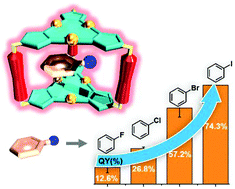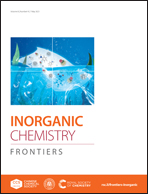Guest-boosted phosphorescence efficiency of a supramolecular cage†
Abstract
Phosphorescent organic light emitting diodes (PhOLEDs) are required to achieve sufficiently high performance of devices; however, the synthesis of a phosphorescent emitter with high quantum efficiency and a short lifetime remains a great challenge. In this work, we synthesized a series of inclusion complexes composed of a phosphorescent Cu6L3 trigonal prismatic cage host and halobenzene guests. Interestingly, the quantum yield (QY) and emission lifetime of the inclusion complexes can be altered with the variation of halogen atoms in the guests due to the increment of spin–orbit coupling (SOC) and the promotion of intersystem crossing (ISC) processes via external heavy-atom effects (HAEs). For instance, on increasing the atomic number of the halogen from F to I, the QY enhanced six times (from 12.6 to 74.3%), while the lifetime reduced nearly two times (33.11 to 18.39 μs) at room temperture. Time-dependent density functional theory (TDDFT) calculations revealed that the encapsulation of iodobenzene guests can greatly promote the ISC processes, which are in good agreement with experimental results. Our studies demonstrated that a simple and efficient approach for designing promising phosphorescent emitters might be useful for PhOLED applications.

- This article is part of the themed collection: FOCUS: Macrocyclic and supramolecular chemistry


 Please wait while we load your content...
Please wait while we load your content...